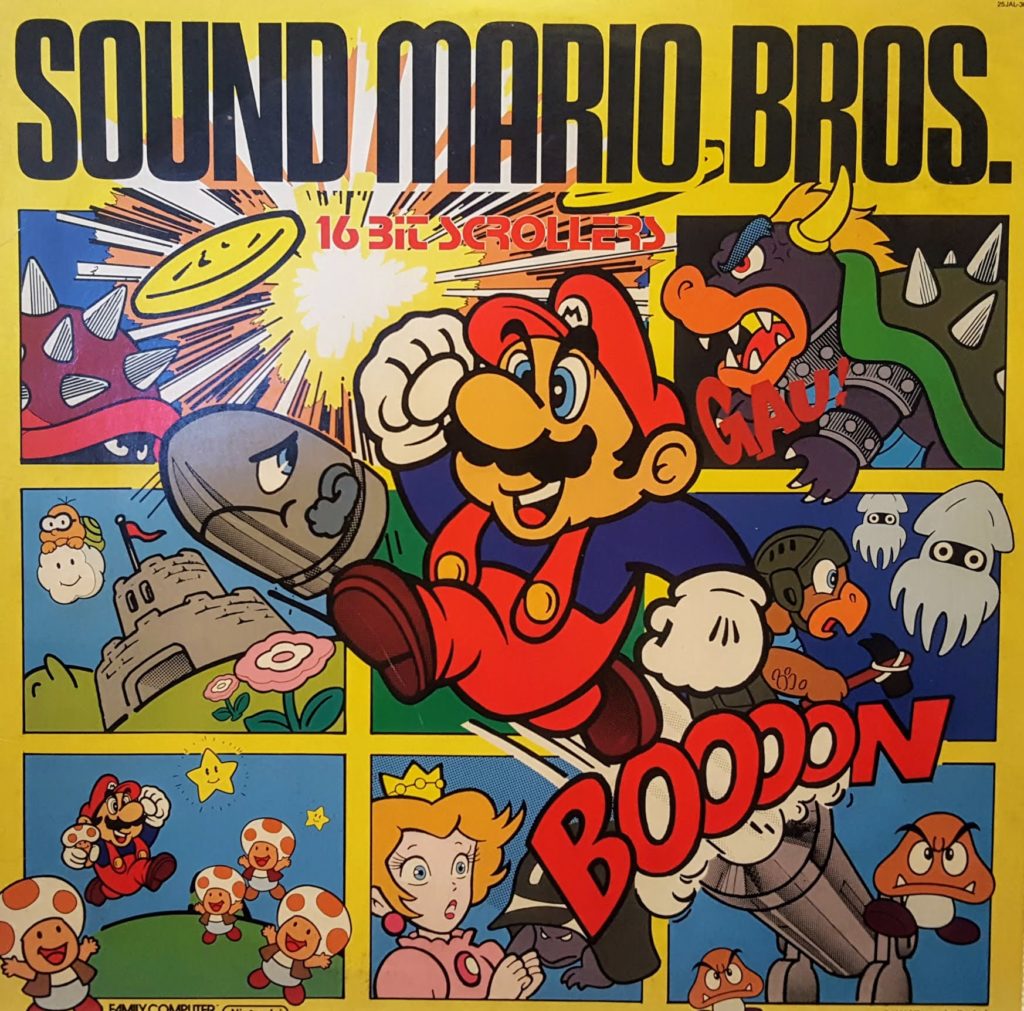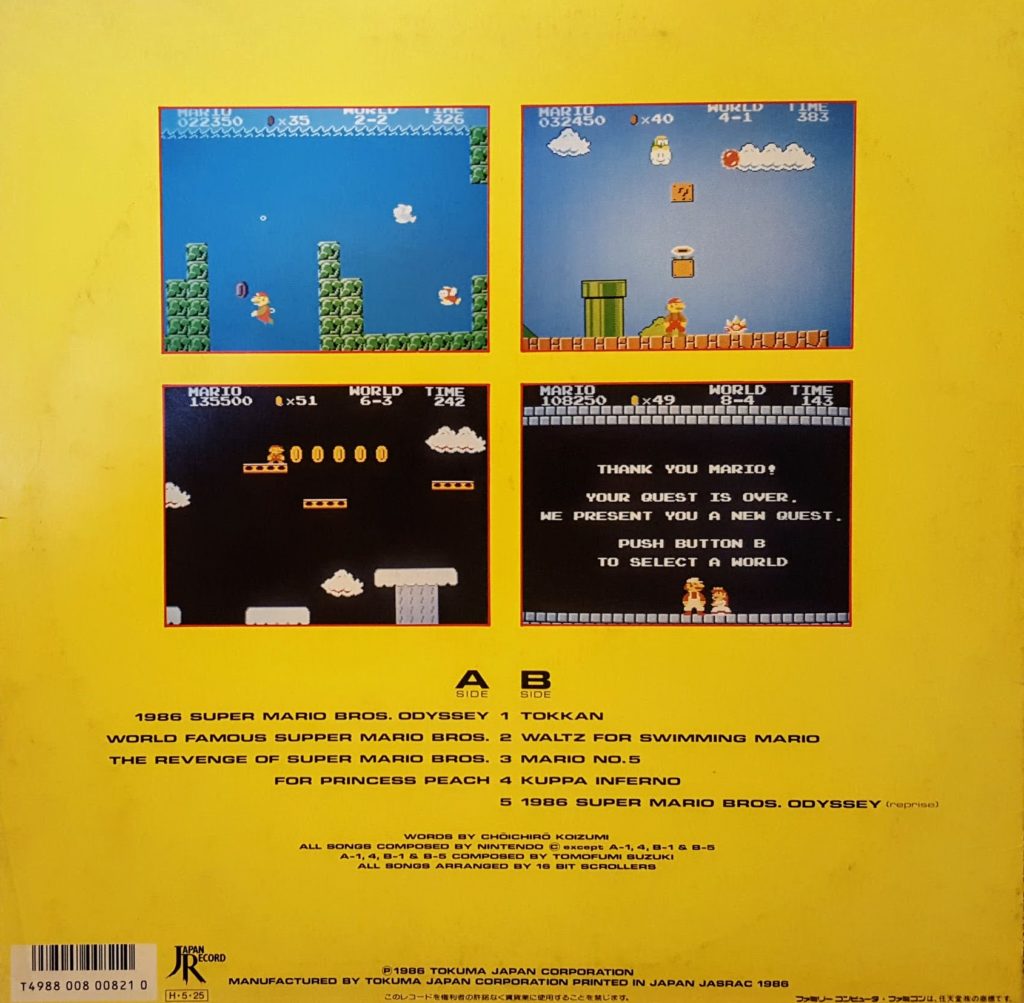Game Music Revue – Sound Mario Bros.

- Credited Composer: 16-Bit Scrollers, Koji Kondo
- Released May 25, 1986
- Label: Japan Record
- VGMdb Information Page
- Discogs Information Page
Man, living in Japan in the 80s must’ve been dope as shit.
Money abound, high-end laserdiscs as far as the eye can see, and a bubble economy so ridiculously overflowing that it allowed for an entire cottage industry of game music covers albums like this one. Sound Mario Bros. by 16-Bit Scrollers isn’t the most original of the bunch, but it has a devotion to the source material that can be appreciated, and an overall technical prowess that can’t be ignored.
After a brief opening fanfare (that cribs from the 20th Century Fox fanfare a bit) the album kicks straight into a rendition of the main Mario theme entitled “World Famous Mario Brothers.” It’s a good take on it, performed with little deviation from the source material and on what were probably state-of-the-art digital synthesizers at the time. A lot of original samples are lifted directly from the game a well. While these can often be distracting in game music arrangements, they’re used rather sparingly here, and as an appropriate accompaniment, often going along with the beat and melody of the theme. I know that sounds like faint praise, but I’ve heard plenty of early game music remixes that just throw in sound effects willy nilly, so this is saying something.
Just like the game itself, the album goes underground next, with “The Revenge Of Super Mario Brothers” offering its take on the game’s underworld theme music. This one deviates from the source material a bit more than the first track, although that makes sense I suppose as the original version is a pretty sparse and minimal tune. I really enjoy the synthesized drums they use on this one, it really gives the tune a nice sense of urgency, and the bassline is just rad. The random screaming in the background is a bit off-putting, but it’s a sold take overall.
Two other tracks on the album are direct reworkings of classic Mario music. The underwater theme shows up as “Waltz For Swimming Mario,” while the castle music is given the title “Kuppa Inferno.” The underwater theme is probably the most boring of the bunch. It’s a very straight-forward take on the theme with little in the way of something original to offer. If someone told me it was a version of the theme that was used in a later Mario game, I’d believe them. “Kuppa Inferno,” on the other hand is a great take on the castle theme, adherent to the original at times, but occasionally deviating in great ways. A strange ghost-like voice sample is thrown in here and there, giving it a really creepy vibe. And it segues to the ending theme quite nicely at the end. The final track to lift from the game is “Mario No. 5,” which is a bit of a medley/mash-up of various motifs found in the game. It’s very sample-heavy and uses a lot of stutter effects. Do you like The Art Of Noise? These guys certainly did.

Aside from the fanfares that open and close the album, there are two original tracks here as well. The first is “For Princess Peach,” a ballad featuring a woman singing in Japanese about, well, Princess Peach (duh). It uses some motifs from the game but is otherwise unremarkable. More memorable is “Tokkan,” an original rap track that uses samples and interpretations of Mario music as its backbeat. One of the people involved with this album worked on an early Japanese hip-hop release (more on him in a bit) and much like that album, this track is surprisingly good. The rap being in Japanese, I can’t pick up 90% of the lyrics, but the flow is decent and it has a solid intensity to it. This is better than most current Japanese hip-hop that’s for sure (although that is not saying much at all, trust me).
16-Bit Scrollers is a weird name for a mid-80s video game covers band, as we were still in the height of the 8-bit era at the time. Maybe they were just forward thinking. Regardless, finding out who exactly the 16-Bit Scrollers are is a bit of a challenge, as the album gives zero information in the way of performance credits. All we have to go by are the technical and writing credits, although I suspect they’re rather telling as to who was actually performing on this record.
The original tracks that make up side B were written by Tomofuki Suzuki, a guitarist and keyboardist who performed with a few different acts in the 70s and 80s. Some of the more notable acts he worked with include early synthpop acts 8 1/2 and Portable Rock. He also worked with Tinnie Punx, one of the first (and best) Japanese hip-hop acts. I suspect “Tokken” was his creation. Given a “words by” credit is Choichiro Koizumi, who doesn’t appear to have had a particularly long-lasting career in music, at least not one that got him a lot of credited releases. He does appear as a songwriter on a few other albums though, including one by Takkyu Ishino, a prolific and influential techno musician in Japan.
This album lacks the originality and creativity of the Akihabara Electric Circus covers albums, but that’s not necessarily a strike against it. The Akihabara albums are crazy, and feature some really bizarre musical choices that, while interesting, don’t always make for a fun listen. This album, on the other hand, is a joy throughout, and the deviations from the source material are different enough to be interesting, but still faithful enough not to be a distraction.
I usually don’t share game music online, as most of what I write about is either relatively new or easy to find in stores used (at least in Japan), but given that this album is pretty rare and goes for a large amount online, I’d figure I’d make an exception this time. Click here to download a vinyl rip of the album. The rip comes courtesy of EverythingSuperMario. My copy was far too scratched to share, and his sounds remarkable.
Leave a Reply